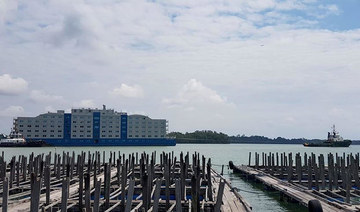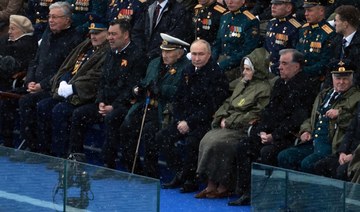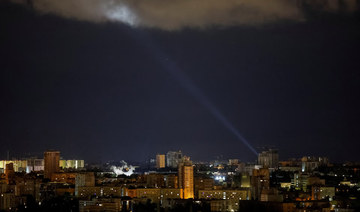SINGAPORE: Singapore will extend a partial lockdown until June 1 to curb a sharp rise in coronavirus infections in the city-state, Prime Minister Lee Hsien Loong said on Tuesday.
The measures, which include the closures of most workplaces and schools and are called a “circuit breaker” by authorities, were initially set to run until May 4.
But the city-state has seen a sharp jump in cases in recent weeks fueled by infections in cramped migrant worker dormitories, many of which are under government-ordered quarantines.
The city-state reported 1,111 new coronavirus cases on Tuesday, bringing total infections to 9,125, after a record daily jump of 1,426 cases on Monday.
“We will therefore extend the circuit breaker for four more weeks,” Lee said in a televised speech.
Lee said the extended lockdown period would help bring community cases down decisively and make sure infections in migrant dormitories do not spread into the wider community.
“Then, provided we have brought the community numbers down, we can make further adjustments and consider easing some measures,” he said.
Singapore’s finance minister said at a media conference that the government would extend economic support measures, including wage subsidies, to help businesses offset the impact of the longer lockdown period at a cost of S$3.8 billion.
The World Health Organization’s regional chief said on Tuesday that Singapore — which has the highest number of reported cases in Southeast Asia — is facing “very difficult challenges” from a recent surge in infections but has the health care system and risk management capacity to handle it.
Singapore extends partial coronavirus lockdown until June 1 as infections surge
https://arab.news/27y62
Singapore extends partial coronavirus lockdown until June 1 as infections surge

- Lockdown measures were initially set to run until May 4
- Extended lockdown period would help bring community cases down decisively
South Africa again requests emergency measures from world court to restrain Israel’s actions in Gaza
South Africa again requests emergency measures from world court to restrain Israel’s actions in Gaza

- The North African country joins Nicaragua and Colombia, which have filed their own requests to take part in the proceedings
- Israel has killed more than 34,700 Palestinians in Gaza, mostly women and children, according to the health ministry in the Hamas-run territory
THE HAGUE, Netherlands: South Africa urged the United Nations’ top court Friday to issue more emergency measures to restrain Israel, saying its military incursion in Rafah threatens the “very survival of Palestinians in Gaza.”
The request marks the fourth for additional measures by South Africa, which filed a genocide case against Israel late last year at the International Court of Justice. According to the latest request, the previous preliminary orders by The Hague-based court were not sufficient to address “a brutal military attack on the sole remaining refuge for the people of Gaza.”
At hearings in January, lawyers for Israel argued that its war in Gaza was a legitimate defense of its people and that it was Hamas militants who were guilty of genocide.
South Africa has asked the court to order Israel to withdraw from Rafah; to take measures to ensure unimpeded access to UN officials, humanitarian organizations and journalists to the Gaza Strip; and to report back within one week as to how it is meeting these demands.
Earlier this week, Israel issued a warning to evacuate an area of eastern Rafah where approximately 100,000 Palestinians have been sheltering. Israeli military forces have now seized the nearby border crossing with Egypt, leaving all entries and exits from the beleaguered enclave under Israeli control.
South Africa also accused Israel of violating the previous provisional measures imposed by the court. In January, judges ordered Israel to do all it could to prevent death, destruction and any acts of genocide in Gaza. Two months later, the court issued a second set of measures, telling Israel to improve the humanitarian situation, including opening more land crossings to allow food, water, fuel and other supplies.
The court also announced on Friday that Libya had asked to join the case and intervene in support of South Africa. The North African country joins Nicaragua and Colombia, which have filed their own requests to take part in the proceedings.
Separately, Nicaragua brought a complaint against Germany, arguing the European country is enabling genocide by sending arms and other support to Israel. Earlier this month, the court rejected a request for emergency measures against Berlin, but the case will continue on merits.
The war began with a Hamas attack on southern Israel on Oct. 7 in which Palestinian militants killed around 1,200 people and took about 250 hostages. The attack sparked an Israeli invasion the Gaza Strip, home to 2.3 million people.
Israel’s bombardment and ground offensives in Gaza have killed more than 34,800 Palestinians, mostly women and children, according to the Gaza Health Ministry, which does not distinguish between civilians and combatants in its figures. Much of Gaza has been destroyed and some 80 percent of Gaza’s population has been driven from their homes.
The UN says northern Gaza is already in a state of “full-blown famine.”
Earth hit by strongest solar storm since 2003: US agency

WASHINGTON: The planet is experiencing its first “extreme” geomagnetic storm since 2003, a US agency said Friday.
“EXTREME (G5) conditions reached Earth at 6:54 p.m. EDT. Geomagnetic storming is likely to persist through the weekend as several additional Earth-directed Coronal Mass Ejection (CMEs) are in transit,” said NOAA’s Space Weather Prediction Center on X.
US announces a new $400 million package of weapons for Ukraine to try to hold off Russian advances

WASHINGTON: The US announced a new $400 million package of military aid for Ukraine on Friday, as Kyiv struggles to hold off advances by Russian troops in the northeast Kharkiv region.
This is the third tranche of aid for Ukraine since Congress passed supplemental funding in late April after months of gridlock. Ukrainian President Volodymyr Zelensky had warned Thursday that his country was facing “a really difficult situation” in the east, but said a new supply of US weapons was coming and “we will be able to stop them.”
The package includes High Mobility Artillery Rocket Systems and rockets for them, as well as munitions for Patriot and National Advanced Surface-to-Air Missile Systems, artillery, anti-aircraft and anti-tank munitions, and an array of armored vehicles, such as Bradley and Mine Resistant Ambush Protected vehicles.

It will also provide a number of coastal and riverine patrol boats, trailers, demolition munitions, high-speed anti-radiation missiles, protective gear, spare parts and other weapons and equipment. The weapons are being sent through presidential drawdown authority, which pulls systems and munitions from existing US stockpiles so they can go quickly to the war front.
White House national security spokesman John Kirby said Friday that the latest military aid was intended, in part, to help Ukraine fend off the surging Russian effort to capture Kharkiv, Ukraine’s second largest city.
Kirby noted that Russia has already launched initial incursions into areas around the towns of Vovchansk and Lyptsi, near Kharkiv.
“It is possible that Russia will make further advances in the coming weeks, but we do not anticipate any major breakthroughs,” Kirby said. “And over time, the influx of US assistance will enable Ukraine to withstand these attacks over the course of 2024.”
The US has now provided about $50.6 billion in military assistance to Ukraine since Russia invaded in February 2022.
Almost immediately after President Joe Biden signed the $95 billion foreign aid package, the Pentagon announced it was sending $1 billion in weapons through that drawdown authority,. And just days later the Biden administration announced a $6 billion package funded through the Ukraine Security Assistance Initiative, which pays for longer-term contracts with the defense industry and means that the weapons could take many months or years to arrive.
Russia has sought to exploit Ukraine’s shortages of ammunition and manpower as the flow of Western supplies since the outbreak of the war petered out while Congress struggled to pass the bill. Moscow has assembled large troop concentrations in the east as well as in the north and has been gaining an edge on the battlefield, Zelensky said.
Officials did not say if the latest package includes more of the long-range ballistic missiles — known as the Army Tactical Missile System — that Ukraine has repeatedly requested. The US secretly sent a number of the missiles to Ukraine for the first time this spring and the White House has said it would send more. In one case, Ukraine used them to bomb a Russian military airfield in Crimea.
The new missiles give Ukraine nearly double the striking distance — up to 300 kilometers (190 miles) — than it had with the mid-range version of the weapon that it received from the US in October.
Russian forces attack Ukraine’s Kharkiv region, striking on new front

- Russian advance seen as a push to create buffer zone
- President Zelensky says Ukraine ready to meet assault
KYIV: Russian forces launched an armored ground attack on Friday near Ukraine’s second city of Kharkiv in the northeast of the country and made small inroads, opening a new front in a war that has long been waged in the east and south.
Ukraine sent reinforcements as fighting raged in the border areas of the region, the defense ministry said, adding that Russia had pounded the frontier town of Vovchansk with guided aerial bombs and artillery.
“Russia has begun a new wave of counteroffensive actions in this direction,” Ukrainian President Volodymyr Zelensky told a news conference in Kyiv. “Now there is a fierce battle in this direction.”
Ukraine had warned of a Russian buildup in the area, potentially signalling preparations for an offensive or a ploy to divert and pin down Ukraine’s overstretched and outnumbered defenders. It was unclear if Moscow would develop the attack.
In its evening battlefield update, the Ukrainian General Staff said for the first time that Russia was also building up forces to the north of Kharkiv near the Ukrainian regions of Sumy and parts of Chernihiv.
Zelensky has said Russia could be preparing a big offensive push this spring or summer. Kyiv’s forces were prepared to meet Friday’s assault, but Moscow could send more troops to the area, he told reporters.
The Ukrainian defense ministry said Russia launched an armored assault at around 5 a.m. In an update at 10 p.m., the General Staff said battles were continued to prevent Russian offensive efforts to advance in the Kharkiv region.

A senior Ukrainian military source who declined to be named said Russian forces had pushed 1 km (0.6 mile) inside the Ukrainian border near Vovchansk.
The source said Russian forces were aiming to push Ukrainian troops as far back as 10 km inside Ukraine as part of an effort to create a buffer zone, but that Kyiv’s troops were trying to hold them back.
The White House said the United States had been coordinating closely with Ukraine on Russia’s Kharkiv offensive.
“It is certainly possible that the Russians are setting themselves up for a larger assault on Kharkiv,” White House national security spokesperson John Kirby told reporters.
Top Ukrainian officials have repeatedly said they do not believe Russia has the force capacity available to launch a successful operation to capture the city of Kharkiv, home to 1.3 million people.
The General Staff said battles raged for control of three frontier villages — Strilecha, Pylna and Borysivka — that were already seen as in a “grey area” of control.
“Counter-offensive measures continue in the direction of the settlements of Lyptsi and Vovchansk. The enemy is using infantry and equipment,” it said on the Telegram app.
Military spokesperson Nazar Voloshyn said fighting was still raging in the evening and that the situation was dynamic. He said he believed Moscow’s operation aimed to draw troops to Kharkiv from the east where Russia is focusing its offensive.
There was no immediate comment from Moscow.
Heavy shelling
At least two civilians were killed and five were injured during heavy shelling of border settlements, said Oleh Synehubov, governor of Kharkiv region.
“All the enemy can do is to attack in certain small groups, you can call them sabotage and reconnaissance groups or something else, and test the positions of our military,” he said.
In Vovchansk, a town with a pre-war population of 17,000 that has dwindled to a few thousand, authorities said they were helping civilians evacuate from the settlement and surrounding areas due to the heavy shelling.
In his evening address, Zelensky said his top commander Oleksandr Syrskyi had reported to him that “heavy fighting” was taking place all along the more than 1,000-km (600-mile) front line.
Ukraine chased Russian troops out of most of the Kharkiv region in 2022, following Russia’s full-scale invasion in February of that year. But after weathering a Ukrainian counteroffensive last year, Russian forces are back on the offensive and slowly advancing in the Donetsk region that lies further south.
Ukrainian concerns grew in March over the Kremlin’s intentions in the Kharkiv region when Russian President Vladimir Putin called for the creation of a buffer zone inside Ukrainian territory. He said this was needed to protect Russia from shelling and border incursions.
Since then, Kharkiv, which is particularly vulnerable because of its proximity to Russia, has been hammered by air strikes that have damaged the region’s power infrastructure.
More than two years after its invasion, Russia has the battlefield momentum and Ukraine faces shortages of manpower and stocks of artillery shells and air defenses.
India’s opposition jubilant as Modi critic Kejriwal gets bail to campaign in elections

- AAP members began celebrating on hearing the news, beating drums, dancing and shouting slogans praising Kejriwal and criticizing Modi as they gathered outside the party office in the capital
NEW DELHI: India’s top court gave temporary bail to Delhi Chief Minister Arvind Kejriwal in a graft case on Friday, allowing him to campaign in the ongoing general elections, boosting the opposition alliance of which he is a prominent figure.
The Supreme Court said Kejriwal — a fierce critic of Prime Minister Narendra Modi — would be out on bail until June 1, the last day of the nationwide seven-phase vote, and would have to return to pre-trial detention on June 2.
India began voting on April 19 and elections for more than half of the 543 seats in parliament have now been completed following the third phase of the vote on May 7.
The two areas governed by Kejriwal’s Aam Aadmi Party — the National Capital Territory that includes New Delhi, and the northern state of Punjab — go to the polls on May 25 and June 1 respectively.
HIGHLIGHT
The two areas governed by Kejriwal’s Aam Aadmi Party — the National Capital Territory that includes New Delhi, and the northern state of Punjab — go to the polls on May 25 and June 1 respectively.
Votes will be counted on June 4 and results are expected to be announced the same day.
“This is the victory of democracy,” Kejriwal’s wife Sunita posted on X after the court order.
AAP members began celebrating on hearing the news, beating drums, dancing and shouting slogans praising Kejriwal and criticizing Modi as they gathered outside the party office in the capital.
“Today, the Supreme Court has struck a ray of hope in the hearts of the people who love this country, the constitution, and democracy ... this is a victory of truth,” Delhi Environment Minister and senior AAP leader Gopal Rai told reporters.
The court had said last week that it may consider granting Kejriwal temporary bail “because of the elections” while it heard an appeal against his arrest, as that hearing could take a while to conclude.
Opposition parties have accused Prime Minister Narendra Modi’s government of using investigative agencies to hurt its rivals, which the government denies.
Over the years Kejriwal has accused Modi and his Bharatiya Janata Party of damaging democracy, promoting corruption, throttling governance in Delhi, abusing their power and attacking the federal structure of the constitution among other things.
The Enforcement Directorate, India’s financial crime-fighting agency, arrested Kejriwal on March 21 in connection with corruption allegations related to the capital territory’s liquor policy.
Kejriwal’s government and his AAP have denied the allegations. Modi and BJP say the investigating agencies are only doing their job and the government is not influencing them.
Kejriwal has been in pre-trial detention since April 1, and his wife Sunita has stepped in to campaign for his decade-old party which has been hobbled by the detention also of two other senior leaders in the same case.
Members of the INDIA alliance of more than two dozen opposition parties — Modi’s main challenger which includes the AAP — said they were pleased that Kejriwal had received bail.
Mamata Banerjee, chief minister of the eastern state of West Bengal and a key INDIA member, said she was “very happy” Kejriwal got bail. “It will be very helpful in the context of the current elections,” she posted on X.
Abhishek Manu Singhvi, Kejriwal’s lawyer, had argued that Kejriwal was arrested just before the vote to stop him from campaigning against Modi, who opinion polls suggest will win a comfortable majority and secure a rare third straight term.
ED lawyers argued that giving bail to a politician just to campaign risked sending the message that there were different standards for such figures compared with other citizens.




















